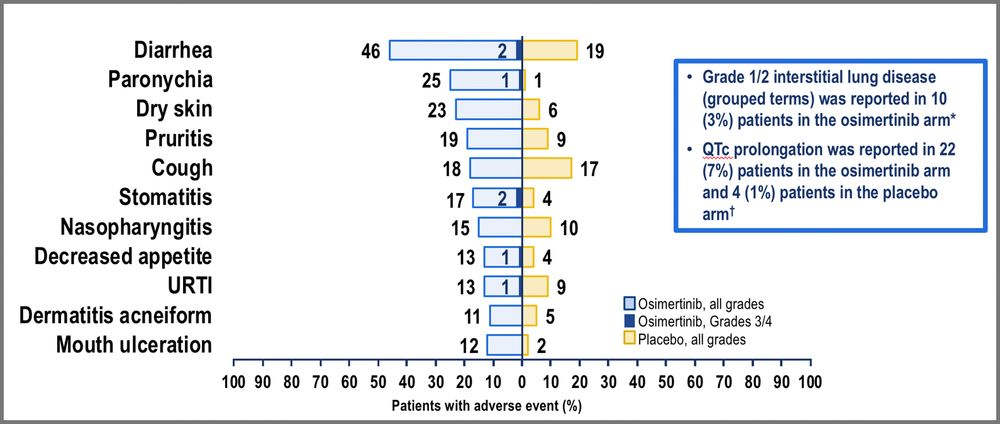




In oncology, figs like Kaplan-Meier curves, waterfall plots, & swimmer plots are central to how we interpret data. A stated HR or diff in med surv is compelling, but visual impact of a figure can make us feel it viscerally (here, CROWN trial 5-yr EFS). (1/5)

In oncology, figs like Kaplan-Meier curves, waterfall plots, & swimmer plots are central to how we interpret data. A stated HR or diff in med surv is compelling, but visual impact of a figure can make us feel it viscerally (here, CROWN trial 5-yr EFS). (1/5)

Among most common problems of slide presentations is a slide full of text (example of mine here). Why? When we see sentences of text, it’s hard for us to avoid temptation to read it verbatim, & audience reads faster than we speak. (1/8)

Among most common problems of slide presentations is a slide full of text (example of mine here). Why? When we see sentences of text, it’s hard for us to avoid temptation to read it verbatim, & audience reads faster than we speak. (1/8)
We should discuss a common error that many of us, myself included, tend to commit. Too often we see slides contain MANY figures of different types: it’s bewildering.
The speaker may apologize, but why make slides we feel compelled to apologize for? (1/6)

We should discuss a common error that many of us, myself included, tend to commit. Too often we see slides contain MANY figures of different types: it’s bewildering.
The speaker may apologize, but why make slides we feel compelled to apologize for? (1/6)
Lest it seem like I'm just going to criticize people's figures & slides, I want to take a moment to salute a beautifully clear, helpful figure called a Sankey chart. It's tailor-made for showing how resources (here, pts) get distributed over time/treatment.
(1 of 2)

Lest it seem like I'm just going to criticize people's figures & slides, I want to take a moment to salute a beautifully clear, helpful figure called a Sankey chart. It's tailor-made for showing how resources (here, pts) get distributed over time/treatment.
(1 of 2)
Thoughts?

Thoughts?
This is what I’d want as a distilled message, probably alongside full AE list.
Thoughts? (6/8)

This is what I’d want as a distilled message, probably alongside full AE list.
Thoughts? (6/8)
Isn't the version on the R easier to show where diffs in AEs exist?
IMO, we should do this variant instead. (5/8)

Isn't the version on the R easier to show where diffs in AEs exist?
IMO, we should do this variant instead. (5/8)
The problem, IMO, is that you can't capture numbers in one field of vision; your eyes need to bounce from L to R to compare numbers. (4/8)

The problem, IMO, is that you can't capture numbers in one field of vision; your eyes need to bounce from L to R to compare numbers. (4/8)

We can’t convey a message in that time. (2/8)

We can’t convey a message in that time. (2/8)
Tables (sometimes BIG) are among most routinely used tools to show data like baseline characteristics & AEs, while “tornado plots” are a standard figure to display AEs & sometimes other variables.
But could we do better, esp for live talks? (1/8)


Tables (sometimes BIG) are among most routinely used tools to show data like baseline characteristics & AEs, while “tornado plots” are a standard figure to display AEs & sometimes other variables.
But could we do better, esp for live talks? (1/8)
How can we show results more clearly? A bar graph (here Tan, JCO, 2022) is mundane but more clear. Skoulidis et al (Nat Rev Cancer, 2019) show frequency of comut’ns w/dot plot.
More thoughts later.(7/7)


How can we show results more clearly? A bar graph (here Tan, JCO, 2022) is mundane but more clear. Skoulidis et al (Nat Rev Cancer, 2019) show frequency of comut’ns w/dot plot.
More thoughts later.(7/7)

Though pie charts are a staple of oncology & especially favored for molecular oncology, they have several problems that make them a poor choice for conveying data clearly. I say this knowing that one like the one here was a cornerstone of my presentations for years. (1/7)

Though pie charts are a staple of oncology & especially favored for molecular oncology, they have several problems that make them a poor choice for conveying data clearly. I say this knowing that one like the one here was a cornerstone of my presentations for years. (1/7)
Great to catch up with so many colleagues, many of whom have been prolific on X but may be thinking about transitioning here. Will try to nudge them along.

Great to catch up with so many colleagues, many of whom have been prolific on X but may be thinking about transitioning here. Will try to nudge them along.

